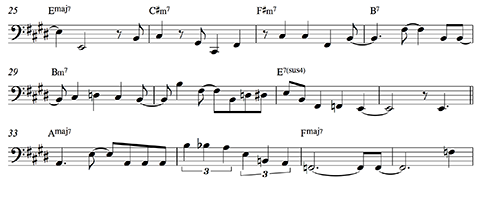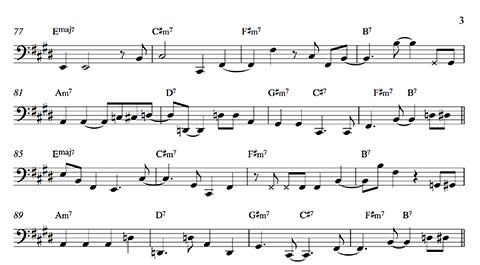Indice - Table of contents
Lo Nuevo[hide]
Grupos: Ritmo Oriental : 1988 - Vol. IX - 30 a...
Musicos: Rafael Paseiro Monzón
Musicos: Dennis Nicles Cobas
Musicos: Jiovanni Cofiño Sánchez
Musicos: Yasser Morejón Pino
Fotos: Tom Ehrlich : 2024 Monterey Jazz, P...
Resenas: Vacilón Santiaguero (Circle 9 ...
Staff: Bill Tilford
Fotos: Tom Ehrlich : 2024 Monterey Jazz, P...
Fotos: Tom Ehrlich : 2024 Monterey Jazz Fe...
Fotos: Tom Ehrlich : testing 123
Grupos: Pupy y los que S... : Discography - 1995- F...
Reportes: From The St... : Cubadisco 2...
Reportes: From The St... : Jazz Plaza ...
Fotos Del Día [hide]
Circúlame
"Circúlame", the fourth track of "Te gusto o te caigo bien", serves as both a fine demonstration of timba-arranging as well as the crisp bass-work of Alexander Abreu. In addition, it is also a flat out great tune that swings infectiously from beginning to end.
The song has a cool “Yin and Yang” quality with it's unusually long, harmonically involved cuerpo in E major and it's gnarly, no nonsense montuno section in E minor. The tune is in 2-3 rumba clave, as is clearly stated on the timbal’s jam block in the eight measure piano intro. Like many timba arrangements, the song opens with a short preview of the montuno section that subsequently occurs later in the track. Abreu enters eight measures in and barely repeats his bassline one and a half times before the song switches gears, changes key and dives head first into the cuerpo.
The shift in tonality gives the track a sudden lift from the weight of the montuno intro, providing a great sense of contrast and movement. After a brief horn intro the main theme of the verse is introduced, primarily centered around a I-vi-ii-V7 progression decorated and augmented here and there with colorful harmonic deviations. Example 1 is a personal favorite of mine, almost akin to Stevie Wonder in its nature.
Example 1

This particular song is a wonderful illustration of the sheer breadth of Abreu's skill and his ability to serve a song while remaining very creative. Within the track his playing exudes the some contrast of the arrangement itself. He's loose and rhythmically adventurous in both the cuerpo and first montuno, rarely repeating ideas as he weaves through the chord changes. However, when the transition to the second montuno section arises, he clamps onto an aggressive ostinato and rarely lets go.
While these aforementioned factors are staples of Abreu’s playing style, what makes this track unique unto itself is the feeling of lightness he seems to induce in the cuerpo. In a way, he almost seems to be persuading the listener to believe the track is less rhythmically dense than it actually is. In reality however he is very active, adding more variations to the tumbao than many bass players would dare. Example 2 below demonstrates just how much content he is willing to pack into a relatively small area while somehow retaining a keen sense of space.
Example 2

Around 1:22 into the track the first of two montuno sections appears. The section is very short; repeating only five times and serves more as an interlude than a full-on montuno section. Overall, it retains the same sparse dynamic of the cuerpo but of course with repeated coros and a looped chord progression. Here Abreu makes an interesting choice not to opt for a full-on repeated pattern but rather continue his “stream of consciousness” approach through this section as well. Over the course of these forty measures, he takes a handful of ideas and skillfully switches between each of them in an effortless and even playful manner as shown in Example 3.
Example 3

At 2:18 yet another transition occurs, this time in the form of a sixteen-measure mambo over a static Emin7 chord. This particular species of mambo is pure Bamboleo. One could say it serves as a composition within a composition, creating such a departure from what has happened before that it establishes almost a blank slate for anything that subsequently ensues. Instead of laying-out entirely, Abreu takes this opportunity to inject some bluesy solo ideas in the first eight bars and pedal E’s over the second eight bars. Example 4 shows his slippery arpeggio lick that outlines a Bmin7 superimposed over Emin7, or an emphasis on the 5th, 7th, 9th and 11th if you prefer.
Example 4

At 2:39 the second montuno comes rolling in. Here Abreu reintroduces his heavy, aggressive tumbao from the beginning of the track. The tumbao is a stern figure that is unapologetically timba in nature, firmly anchoring the groove in place. In fact, if you listen carefully you can hear him and the rest of the rhythm section pull back ever so slightly at the beginning of this section, thus countering the natural tendency to rush after the buildup of the previously occurring mambo.
Example 5 shows Abreu’s main tumbao for the second montuno, a i-ii7b5-V7 progression in E minor that is two claves in length. The line is a deft example of utilizing the nature of the clave in its most simple yet effective manner. Notice the use of quarter notes on the two-side of the clave with almost an entire measure of rest on the three-side. The use of three eight notes leading into the downbeats on both two sides is classic Abreu and is a similar rhythmic technique to that used by many timba pianists and bassists alike.
Example 5

Contrary to his cuerpo approach, Abreu does very little to change his bassline in the final montuno section. Instead he opts to give the rest of the band the opportunity to move around him, exhibiting a great sense of restraint, patience and control. If you listen carefully to each repetition of the figure you can hear Abreu subtly sustaining and leaving out notes here and there in order to add flavor to the groove and interact with the singers and the other instruments in the band.
Example 6a

At 3:50 another horn mambo comes in and the dynamic of the group comes down. In reaction to this, Abreu employs a simple yet very funky variation to his tumbao figure by leaving out beats one and two in the first measure.
Example 6b

Overall, “Circúlame” is a worthy study for any aspiring timba bassist. In my personal opinion it is one of the most interesting examples of creative cuerpo playing in the Bamboleo catalog. Every eight-measure phrase is a treasure trove of fresh ideas, each being a worthwhile lesson in itself. All in all, it is a summation of Abreu himself; a player of skill and maturity that in many ways belied the somewhat adolescent period of Bamboleo in which he was associated.





















